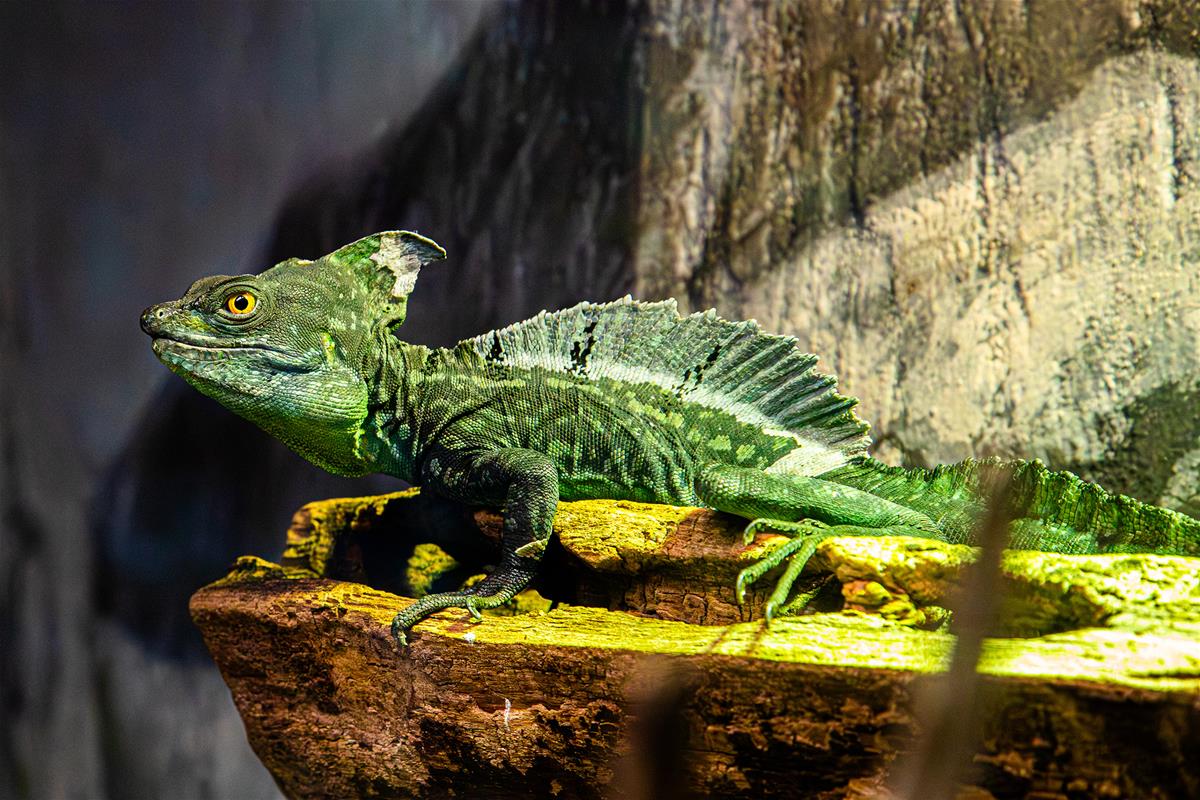Viewable


Location at the Zoo
Indo-Malaya
Global Range
Central America
Green Crested Basilisk
Basiliscus plumifrons
The Green Crested Basilisk is a striking and agile lizard known for its bright green colouration, long limbs, and the distinctive crescent-shaped crest that runs along the head, back, and tail of adult males. Individuals commonly reach 60 to 75 centimetres in total length, much of which is tail. Its slender build, exceptionally long toes, and lightweight frame allow it to perform its most famous behaviour—running across the surface of water. This ability has earned it the nickname “Jesus Christ lizard.”
Its body is marked with blue and yellow speckles, and the eyes are typically golden with round pupils. Males are more vividly coloured and have taller crests than females. The species is primarily arboreal, moving easily through branches above forest streams. In zoological settings, it often becomes a highlight for visitors due to its unusual locomotion and vivid colouration.
HEAD AND BODY LENGTH
The body itself typically measures 20 to 25 centimetres, with the full length including tail reaching 60 to 75 centimetres.
WEIGHT
Usually between 150 and 250 grams, depending on age and sex.
Conservation Status: IUCN

Distribution
Occurs in lowland rainforests of Honduras, Nicaragua, Costa Rica, and Panama, generally at elevations below 600 metres.
Habitat
Prefers humid tropical forests, especially areas near streams, rivers, and pools where overhanging vegetation provides both refuge and access to water. It spends much of its time in shrubs or small trees and will drop to the water to escape predators, often sprinting across the surface using rapid, slapping strides.
Diet
The Green Crested Basilisk has an omnivorous diet. It feeds on insects, spiders, small lizards, fruit, flowers, and occasionally small vertebrates such as nestling birds or amphibians. Its strong jaws and quick reflexes allow it to catch fast-moving prey, while its climbing ability gives it access to fruiting branches and forest understory plants.
Reproduction
Breeding occurs throughout the year in warm, humid climates. After mating, females lay clutches of 10 to 20 eggs in moist soil or leaf litter, often in shallow burrows near water. Incubation lasts roughly two to three months, depending on temperature. Hatchlings emerge fully independent and are capable of climbing and swimming immediately, though they rely heavily on camouflage and speed to avoid predators.
Adaptation
The basilisk’s ability to run across water comes from a combination of elongated hind limbs, fringed toes, and rapid movement that creates lift and prevents it from sinking immediately. Strong claws enable climbing through tangled vegetation, while its bright green colouration blends with sunlit leaves. The crest in males may play a role in territorial display or mate attraction. Its large eyes provide sharp vision in low forest light, aiding both predator awareness and precise prey capture.
Threats to Survival
Although globally secure, the species is sensitive to the loss of forested stream corridors. Deforestation, water pollution, and disturbance from human activity can reduce suitable habitat, particularly in unprotected lowland regions. Predation by domestic animals and capture for local trade can affect small populations, but these pressures are not currently severe at a species-wide scale.












